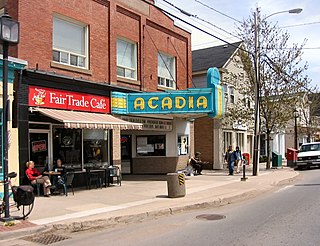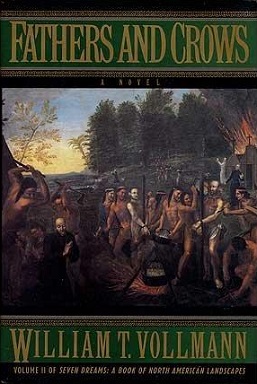Related Research Articles

Wolfville is a Canadian town in the Annapolis Valley, Kings County, Nova Scotia, located about 100 kilometres (62 mi) northwest of the provincial capital, Halifax. The town is home to Acadia University and Landmark East School.

Samuel de Champlain was a French explorer, navigator, cartographer, draftsman, soldier, geographer, ethnologist, diplomat, and chronicler. He made between 21 and 29 trips across the Atlantic Ocean, and founded Quebec, and New France, on 3 July 1608. An important figure in Canadian history, Champlain created the first accurate coastal map during his explorations and founded various colonial settlements.
This article contains information about the literary events and publications of 1606.

This section of the timeline of New France history concerns the events between Jacques Cartier's first voyage and the foundation of the Quebec settlement by Samuel de Champlain.
Saint Croix Island, long known to locals as Dochet Island, is a small uninhabited island in Maine near the mouth of the Saint Croix River that forms part of the Canada–United States border separating Maine from New Brunswick. The island is in the heart of the traditional lands of the Passamaquoddy people who, according to oral tradition, used it to store food away from the dangers of mainland animals. The island was the site of an early attempt at French colonization by Pierre Dugua, Sieur de Mons in 1604. In 1984 it was designated by the United States Congress as Saint Croix Island International Historic Site. There is no public access to the island, but there is a visitor contact station on the U.S. mainland and a display on the Canadian mainland opposite the island.

Port-Royal National Historic Site is a National Historic Site located on the north bank of the Annapolis Basin in the community of Port Royal, Nova Scotia, Canada. The site is the location of the Habitation at Port-Royal.

Marc Lescarbot was a French author, poet and lawyer. He is best known for his Histoire de la Nouvelle-France (1609), based on his expedition to Acadia (1606–1607) and research into French exploration in North America. Considered one of the first great books in the history of Canada, it was printed in three editions, and was translated into German. Lescarbot also wrote numerous poems. His dramatic poem Théâtre de Neptune was performed at Port Royal as what the French claim was the first European theatrical production in North America outside of New Spain. Bernardino de Sahagún, and other 16th-century Spanish friars in Mexico, created several theatrical productions, such as Autos Sacramentales.

Annapolis Royal, formerly known as Port Royal, is a town located in the western part of Annapolis County, Nova Scotia, Canada.
Chief Henri Membertou was the sakmow of the Mi'kmaq First Nations tribe situated near Port Royal, site of the first French settlement in Acadia, present-day Nova Scotia, Canada. Originally sakmow of the Kespukwitk district, he was appointed as Grand Chief by the sakmowk of the other six districts. Membertou claimed to have been a grown man when he first met Jacques Cartier, which makes it likely that he was born in the early years of the sixteenth century.

The Order of Good Cheer was originally a French Colonial order founded in 1606 by suggestion of Samuel de Champlain. A contemporary order awarded by the Province of Nova Scotia bears the same name in continuance of the original order.

Old Quebec is a historic neighbourhood of Quebec City, Quebec, Canada. Comprising the Upper Town and Lower Town, the area is a UNESCO World Heritage Site. Administratively, Old Quebec is part of the Vieux-Québec–Cap-Blanc–colline Parlementaire district in the borough of La Cité-Limoilou.

The history of Quebec City extends back thousands of years, with its first inhabitants being the First Nations peoples of the region. The arrival of French explorers in the 16th century eventually led to the establishment of Quebec City, in present-day Quebec, Canada. The city is one of the oldest European settlements in North America, with the establishment of a permanent trading post in 1608.

Fort Charlesbourg Royal (1541—1543) is a National Historic Site in the Cap-Rouge neighbourhood of Quebec City, Quebec, Canada. Established by Jacques Cartier in 1541, it was France's first attempt at a colony in North America, and was abandoned two years later. In 1608, France would establish a successful colony, the Habitation de Québec, 15 kilometers east of the Cap-Rouge fort.

Fathers and Crows is a 1992 historical novel by the American author William T. Vollmann. It is the second book in the seven-book series Seven Dreams: A Book of North American Landscapes.
Énemond Massé was a French Jesuit missionary, one of the first Jesuits sent to New France.

Fort Ville-Marie was a French fortress and settlement established in May 1642 by a company of French settlers, led by Paul de Chomedey de Maisonneuve, on the Island of Montreal in the Saint Lawrence River at the confluence of the Ottawa River, in what is today the province of Quebec, Canada. Its name is French for "City of Mary", a reference to the Blessed Virgin Mary.
Henry Percival Biggar was a historian and Canadian archivist. After studies at the Upper Canada College of Toronto, at the University of Toronto and at the University of Oxford, he worked with Archives nationales du Canada and became chief archivist of Canada in Europe from 1905 until his death.
The Lake Lescarbot is located in the La Tuque, in Mauricie, in Quebec, in Canada. The territory is administered by Zec Kiskissink.
The Champlain Society seeks to advance knowledge of Canadian history through the publication of scholarly books of primary records of voyages, travels, correspondence, diaries and governmental documents and memoranda. The Society is named after Samuel de Champlain (1574–1635), the explorer, founder of New France and author of numerous exploratory narratives. The Society is a registered, not-for-profit charity administered by a voluntary and unpaid team of council members and officers. It was chartered in Ontario in 1927. Membership is open to all who have an interest in Canadian history. It is based in Toronto, Ontario.
Captain Savalette was a Basque ship's captain who, in 1607, reportedly had been fishing off Canso, Nova Scotia since 1565.
References
- 1 2 Gordon, Alan (2016). Time Travel: Tourism and the Rise of the Living History Museum in Mid-Twienth-Century-Canada. UBC Press. p. 67. ISBN 9780774831536 . Retrieved 19 August 2018.
- ↑ Brown, Wayde (2018). Reconstructing Historic Landmarks: Fabrication, Negotiation, and the Past. Routledge. p. 36. ISBN 9781138648319 . Retrieved 19 August 2018.
- ↑ "Designation information Port-Royal National Historic Site". Parks Canada. 15 June 2018. Retrieved 20 August 2018.
- ↑ Hicks, R. Keith (December 1927). "The Theatre of Neptune in New France by Marc Lescarbot (review)". Canadian Historical Review. 8 (4): 331–332. Retrieved 19 August 2018.
- ↑ Gordon 2016, p. 68.
- ↑ "Port-Royal National Historic Site Celebrates 75 Years since Reconstruction". Government of Canada. 30 June 2016. Retrieved 20 August 2018.
- ↑ Gordon 2016, p. 71-72.
- 1 2 3 "Richardson, Harriette Taber National Historic Person". Parks Canada. Retrieved 3 May 2021.